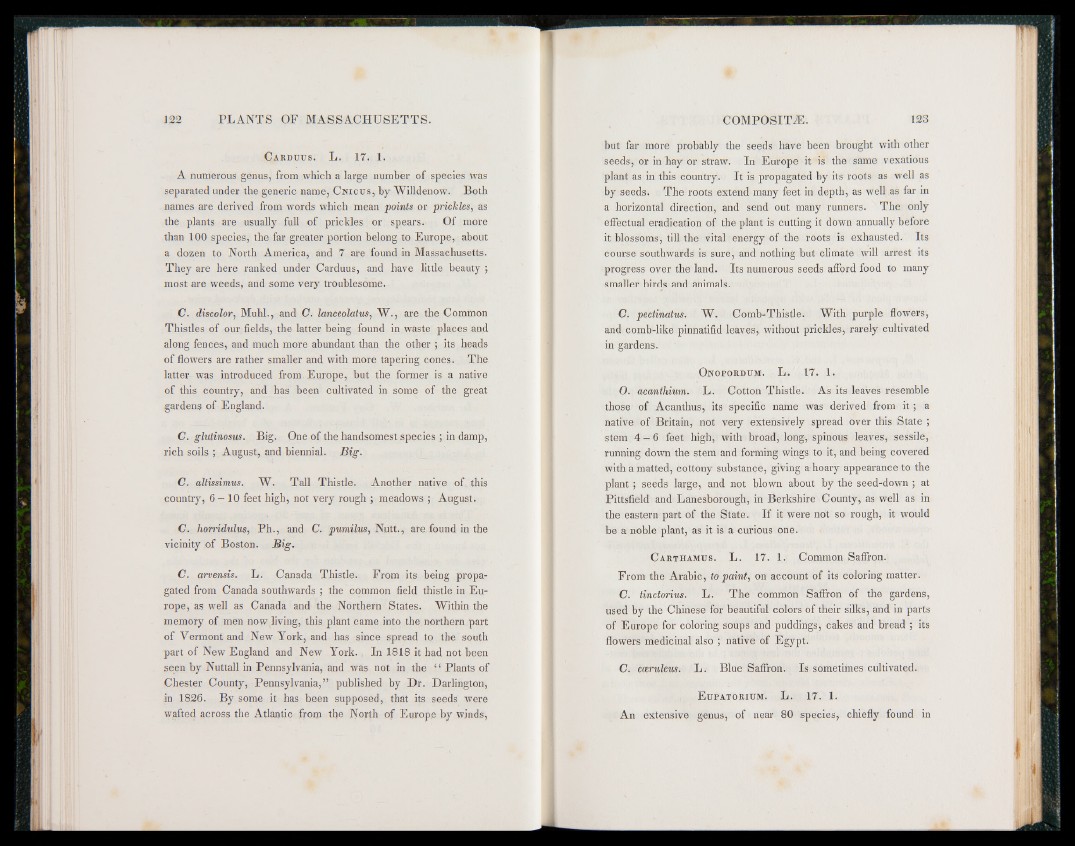
Carduus. L. 17. 1.
A numerous genus, from which a large number of species was
separated under the generic name, Cnicus, by Willdenow. Both
names are derived from words which mean points or prickles, as
the plants are usually full of prickles or spears. Of more
than 100 species, the far greater portion belong to Europe, about
a dozen to North America, and 7 are found in Massachusetts.
They are here ranked under Carduus, and have little beauty ;
most are weeds, and some very troublesome.
C. discolor, Mulil., and C. lanceolatus, W., are the Common
Thistles of our fields, the latter being found in waste places and
along fences, and much more abundant than the other ; its heads
of flowers are rather smaller and with more tapering cones. The
latter was introduced from Europe, hut the former is a native
of this country, and has been cultivated in some of the great
gardens of England.
C. glutinosus. Big. One of the handsomest species ; in damp,
rich soils ; August, and biennial. Big.
C. altissimus. W. Tall Thistle. Another native of this
country, 6 — 10 feet high, not very rough ; meadows ; August.
C. horridulus, Ph., and C. pumilus, Nutt., are found in the
vicinity of Boston. Big.
C. arvensis. L. Canada Thistle. From its being propagated
from Canada southwards ; the common field thistle in Europe,
as well as Canada and the Northern States. Within the
memory of men now living, this plant came into the northern part
of Vermont and New York, and has since spread to the south
part of New England and New York. In 1818 it had not been
seen by Nuttall in Pennsylvania, and was not in the “ Plants of
Chester County, Pennsylvania,” published by Dr. Darlington,
in 1826. By some it has been supposed, that its seeds were
wafted across the Atlantic from the North of Europe by winds,
but far more probably the seeds have been brought with other
seeds, or in bay or straw. In Europe it is the same vexatious
plant as in this country. It is propagated by its roots as well as
by seeds. The roots extend many feet in depth, as well as far in
a horizontal direction, and send out many runners. The only
effectual eradication of the plant is cutting it down annually before
it blossoms, till the vital energy of the roots is exhausted. Its
course southwards is sure, and nothing but climate will arrest its
progress over the land. Its numerous seeds afford food to many
smaller birds and animals.
C. pectinatus. W. Comb-Thistle. With purple flowers,
and comb-like pinnatifid leaves, without prickles, rarely cultivated
in gardens.
Onopordum. L. 17. 1.
O. acanthium. L. Cotton Thistle. As its leaves resemble
those of Acanthus, its specific name was derived from i t ; a
native of Britain, not very extensively spread over this State ;
stem 4 - 6 feet high, with broad, long, spinous leaves, sessile,
running down the stem and forming wings to it, and being covered
with a matted, cottony substance, giving a hoary appearance to the
plant; seeds large, and not blown about by the seed-down ; at
Pittsfield and Lanesborough, in Berkshire County, as well as in
the eastern part of the State. If it were not so rough, it would
be a noble plant, as it is a curious one.
Carthamus. L. 17. 1. Common Saffron.
From the Arabic, to paint, on account of its coloring matter.
C. tinctorius. L. The common Saffron of the gardens,
used by the Chinese for beautiful colors of their silks, and in parts
of Europe for coloring soups and puddings, cakes and bread ; its
flowers medicinal also ; native of Egypt.
C. cmrulcus. L. Blue Saffron. Is sometimes cultivated.
E upatorium. L. 17. 1.
An extensive genus, of near 80 species, chiefly found in